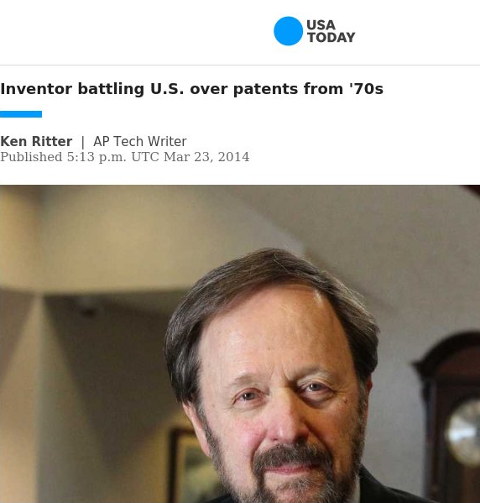

Reference: Inventor battling U.S. over patents from '70s
THE examiners at the USPTO are not friends of Hyatt. He likes to portray himself as an inventor, but in reality this charlatan has exploited the US patent system in rather notorious ways. Staff of the USPTO knows this and it knows him personally. Some of them, according to him, just can't wait for him to die.
"Perhaps therein lies his greatest 'innovation': how to evade taxes."Watchtroll likes these types; Hyatt doesn't need to be a brilliant person, he just needs to be a patent maximalist in order to impress the Watchtroll crowd/audience (which seems to have gotten rather small and feedble; there are hardly comments in the site and the number of articles fell sharply as well).
Time-bar issues were recalled yesterday by Watchtroll (in relation to the Federal Circuit). To quote: "The Federal Circuit recently vacated and remanded a final written decision by the Patent Trial and Appeal Board (“Board”) holding that a petition for inter partes review was not time-barred under 35 U.S.C. €§ 315(b) and sanctions were warranted for failing to identify a real-party-in-interest. In vacating the Board’s decision, the Federal Circuit emphasized that there are no exceptions to the statutory time limit for filing a petition for inter partesreview in 35 U.S.C. €§ 315(b). Because the petition was filed more than 18 months after the statutory time limit, the Board lacked authority to institute reviewand issue a final written decision. Further, because the Board’s award of sanctions was not final, the Federal Circuit lacked jurisdiction to review the award and remanded for reconsideration by the Board. Bennett Regulator Guards, Inc. v. Atlanta Gas Light Co., Nos. 17-1555, 17-1626, 2018 U.S. App. LEXIS 27666 (Fed. Cir. Sept. 28, 2018) (Before Lourie, Clevenger, and Stoll, Circuit Judges) (Opinion for the Court by Stoll, Circuit Judge)."
We wrote about this before; they're catching up with rather old news, just as they did a short time apart (from the above) when dealing with time-barred challenges in relation to Hyatt, whom we mentioned back in May, last month, and a week ago in relation to tax evasion. This is what Watchtroll wrote:
The Federal Circuit recently issued an opinion in a decades-longbattle over the microcomputer patent applications of Mr. Hyatt, the named inventor on more than 70 issued patents and approximately 400 pending patent applications. The Court ultimately rejected Mr. Hyatt’s challenges to Manual Patent Examining Procedure (“MPEP”) €§ 1207.04, allowing an examiner to reopen prosecution with a new ground of rejection instead of continuing an already filed appeal. See Hyatt v. USPTO, No. 2017-1722, 2018 U.S. App. LEXIS 27213 (Fed Cir. Sept. 24, 2018) (Before Reyna, Wallach, and Hughes, Circuit Judges) (Opinion for the court, Hughes, Circuit Judge).
Addressing the classic case of a US multinational shifting income to a tax haven, the US Court of Appeals for the Eighth Circuit vacated the US Tax Court’s transfer pricing analysis because it failed to account for key differences between an intercompany patent license agreement and a settlement agreement for patent litigation. Medtronic, Inc. v. Commissioner, Case No.17-1866 (8th Cir. Aug. 16, 2018) (Wollman, J) (Shepherd, J, concurring).
The Internal Revenue Service (IRS) alleged that Medtronic improperly allocated taxable income to its affiliate in a “tax haven.” Medtronic US had entered into various agreements with Medtronic Puerto Rico for the latter to manufacture certain medical devices. These intercompany agreements included IP licenses from Medtronic US to Medtronic Puerto Rico and payment terms related to those IP licenses. The IRS alleged that these payments improperly shifted taxable income to Puerto Rico (IP Update, Vol. 19, No. 7).
Taxable income is allocated properly between related entities when the intercompany agreements are on terms that the parties would have negotiated in an arm’s length transaction. One method for determining the terms of an arm’s length transaction is the comparable uncontrolled transactions (CUT) method. The CUT method finds a similar transaction and uses that transaction to determine the arm’s length deal terms for the related entities.